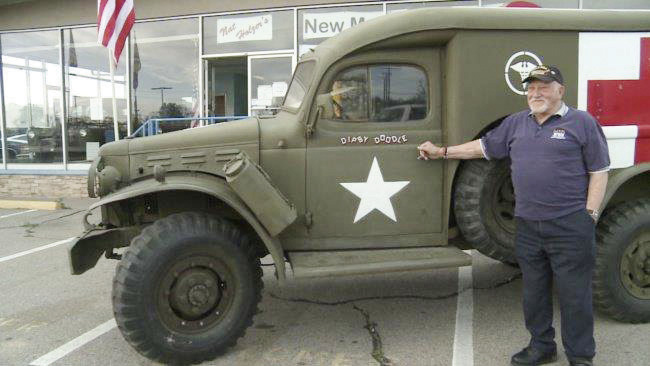Seventy-one years ago, a young soldier left his World War II ambulance in a vehicle “graveyard”and returned to his home state of Wisconsin.Thomas Grasser thought he had said his final goodbye to the ambulance he drove so many years ago when he left it in a German vehicle graveyard and returned home at the end of the war. To his surprise, he stumbled upon the same ambulance last year in Albuquerque.
At the age of 91, Grasser decided to visit the New Mexico Museum of Military History, never expecting to encounter his long lost “home on wheels.” When Grasser informed the museum’s workers, board member Harry Misel had museum representatives check every possible detail they could.They concluded that the ambulance in their museum was in fact piloted by Grasser over seven decades ago. According to Misel, there was no doubt about its authenticity.
Grasser, now a resident of Albuquerque, grew up in Kenosha, Wisconsin, before being drafted into the army. He was, fortunately, able to graduate and obtain his high school diploma beforehand. After his high school graduation on June 11, 1943, Grasser had a brief six-day break before being sworn into the army. Somewhat surprisingly, as Grasser didn’t know how to drive, he was assigned the role of ambulance driver. His training kicked off in California.
Grasser joked about leaving some marks on the redwood trees, in reference to some of the trainees’ mistakes during driving lessons. Upon completing basic training, Grasser shipped out to England at the beginning of 1944, where he continued his training on the rough slopes in the north of the country for a few months.
“But all of a sudden, the sky was just black with planes coming and going,” he recalled. The planes he saw were associated with the onset of D-Day in France. Roughly three weeks after seeing these planes, Grasser was headed for Omaha Beach. The maritime landing craft could not properly get ambulances to shore, forcing soldiers to drive through shallow water.
This environment forced the ambulance drivers to adapt, making their vehicles as waterproof as possible. Many men encased parts of the engines in waxy gauze, duct-taped doors, and inserted tubes into tail pipes to act as snorkels. Upon landing, they drove atop metal grates laid in the sand for additional traction.
Grasser and his fellow ambulance drivers joined convoys headed towards the front. During one of his many harrowing experiences, planes dropped flares on one of his convoys. Grasser assumed someone was attempting to take a picture of their convoy. Unfortunately, the flares illuminated the troops to facilitate a German gun run. Grasser admitted that all the guys were scared kids in that moment.
Grasser was relieved that the German war planes acknowledged the United States medical personnel and pulled up before striking the ambulances, after seeing the Red Cross atop the vehicles. During his time in France, Grasser was part of the 593rd Motor Ambulance Company in Gen. George Patton’s 3rd Army. He was responsible for transporting wounded soldiers from casualty collection points to evacuation hospitals. By the end of the war, he was assigned to the 5th Armored Division.
At one point, his unit drove up to a field near Malmedy, Belgium, where retreating Germans had slaughtered about 85 American prisoners of war and left the bodies. Grasser describes that as one of the worst things he has ever witnessed in his life. Seeing the bodies of 85 POWs that were slain by Germans is something he wishes he could forget.
His career was filled with accomplishments. He personally traveled through France, Belgium and Luxembourg to Germany, and his company evacuated 25,000 patients between Omaha Beach and Aichach, Germany, also aiding in the liberation of two concentration camps.
“To this day, I always say I had an angel on my shoulder because I didn’t get a scratch,” he said. Grasser estimated that he and his company were two weeks out from entering the Pacific theater when the atomic bombs were dropped on Japan. Instead of fighting on a new front, Grasser went home in ’45.
After such a long time at war, Grasser moved to Santa Fe to attend art school in 1949. After a long life and many more memories, Grasser caught wind of a World War II ambulance on display in a local museum from his church’s usher. After a brief discussion, the two decided to visit the museum. Misel showed the two the ambulance and Grasser quickly recognized the numbers on the bumper identifying the vehicle as the ambulance he driven through so many fights. Grasser could not believe it, since the chances seemed close to nil.
Misel, however, cited a photo of Grasser with an ambulance that adorned the same last three digits of the vehicles serial number on the hood. The vehicle was donated by Nat Holzer, a Santa Fe collector and WWII Pacific Theater veteran.
Misel added that though it had been part of Holzer’s collection, it was unclear where he had gotten it from. Unfortunately, Holzer had passed away in 2008, but his children are looking for the ambulance’s title to learn more of the back story on this historic vehicle. Since Grasser made the discovery, he has had the chance to appear publicly with the ambulance and tell its story. The most recent opportunity came at a gun show earlier this month.
“God knows, I’m no hero,” he said. “I’m just the lucky guy who outlived all the others.”
